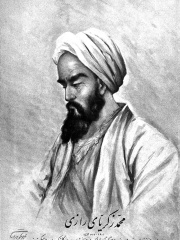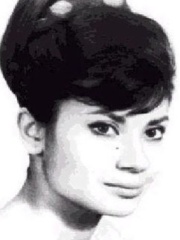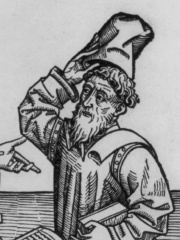




The Most Famous
PHYSICIANS from Iran
This page contains a list of the greatest Iranian Physicians. The pantheon dataset contains 726 Physicians, 6 of which were born in Iran. This makes Iran the birth place of the 25th most number of Physicians behind Finland, and Australia.
Top 6
The following people are considered by Pantheon to be the most legendary Iranian Physicians of all time. This list of famous Iranian Physicians is sorted by HPI (Historical Popularity Index), a metric that aggregates information on a biography's online popularity.

1. Muhammad ibn Zakariya al-Razi (865 - 925)
With an HPI of 79.17, Muhammad ibn Zakariya al-Razi is the most famous Iranian Physician. His biography has been translated into 86 different languages on wikipedia.
Abū Bakr al-Rāzī, also known as Rhazes (full name: أبو بکر محمد بن زکریاء الرازي, Abū Bakr Muḥammad ibn Zakariyyāʾ al-Rāzī), c. 864 or 865–925 or 935 CE, was a Persian physician, philosopher and alchemist who lived during the Islamic Golden Age. He is widely regarded as one of the most important figures in the history of medicine, and also wrote on logic, astronomy and grammar. He is also known for his criticism of religion, especially with regard to the concepts of prophethood and revelation. However, the religio-philosophical aspects of his thought, which also included a belief in five "eternal principles", are fragmentary and only reported by authors who were often hostile to him. A comprehensive thinker, al-Razi made fundamental and enduring contributions to various fields, which he recorded in over 200 manuscripts, and is particularly remembered for numerous advances in medicine through his observations and discoveries. An early proponent of experimental medicine, he became a successful doctor, and served as chief physician of Baghdad and Ray hospitals. As a teacher of medicine, he attracted students of all backgrounds and interests and was said to be compassionate and devoted to the service of his patients, whether rich or poor. Along with Thābit ibn Qurra (836–901), he was one of the first to clinically distinguish between smallpox and measles. Through translation, his medical works and ideas became known among medieval European practitioners and profoundly influenced medical education in the Latin West. Some volumes of his work Al-Mansuri, namely "On Surgery" and "A General Book on Therapy", became part of the medical curriculum in Western universities. Edward Granville Browne considers him as "probably the greatest and most original of all the Muslim physicians, and one of the most prolific as an author". Additionally, he has been described as the father of pediatrics, and a pioneer of obstetrics and ophthalmology.

2. 'Ali ibn al-'Abbas al-Majusi (930 - 994)
With an HPI of 63.96, 'Ali ibn al-'Abbas al-Majusi is the 2nd most famous Iranian Physician. His biography has been translated into 18 different languages.
'Ali ibn al-'Abbas al-Majusi (Persian: علی بن عباس مجوسی; died between 982 and 994), also known as Masoudi, or Latinized as Haly Abbas, was a Persian physician and psychologist from the Islamic Golden Age, most famous for the Kitab al-Maliki or Complete Book of the Medical Art, his textbook on medicine and psychology.

3. Ali ibn Sahl Rabban al-Tabari (838 - 870)
With an HPI of 63.16, Ali ibn Sahl Rabban al-Tabari is the 3rd most famous Iranian Physician. His biography has been translated into 17 different languages.
Ali ibn Sahl Rabban al-Tabari (Persian: علی ابن سهل ربن طبری آملی; c. 838 – c. 870 CE; also given as 810–855 or 808–864 also 783–858), was a Persian Muslim scholar, physician and psychologist, who produced one of the first Islamic encyclopedia of medicine titled Firdaws al-Hikmah ("Paradise of Wisdom"). Ali ibn Sahl spoke Syriac and Greek, the two sources of the medical tradition of Antiquity which had been lost by medieval Europe, and transcribed in meticulous calligraphy. His most famous student was the physician and alchemist Abu Bakr al-Razi (c. 865–925). Al-Tabari wrote the first encyclopedic work on medicine. He lived for over 70 years and interacted with important figures of the time, such as Muslim caliphs, governors, and eminent scholars. Because of his family's religious history, as well as his religious work, al-Tabarī was one of the most controversial scholars. He first discovered that pulmonary tuberculosis is contagious. Outside the rational sciences, as a convert from Christianity to Islam he was also involved in interreligious polemics, writing two works critical of his former religion, al-Radd ´alā l-Nasārā (The Refutation of the Christians) and Kitāb al-Dīn wa-l-Dawla (The Book of Religion and Empire), both of which having been published by Brill in 2016 in a single book, The Polemical Works of ʿAlī al-Ṭabarī.

4. Masawaiyh (777 - 857)
With an HPI of 62.29, Masawaiyh is the 4th most famous Iranian Physician. His biography has been translated into 18 different languages.
Yuhanna ibn Masawaih (circa 777–857), (Arabic: يوحنا بن ماسويه), also written Ibn Masawaih, Masawaiyh, and in Latin Janus Damascenus, or Mesue, Masuya, Mesue Major, Msuya, and Mesuë the Elder was a Persian or Assyrian physician trained by Jabril ibn Bukhtishu who was a member of the Church of the East. from the Academy of Gondishapur. According to The Canon of Medicine for Avicenna and 'Uyun al-Anba for the medieval Arab historian ibn Abi Usaybi'a, Masawaiyh's father was Assyrian and his mother a Slav.

5. Borzuya (500 - 600)
With an HPI of 56.54, Borzuya is the 5th most famous Iranian Physician. His biography has been translated into 17 different languages.
Borzuya (or Burzōē or Burzōy or Borzouyeh, Persian: بُرْزویه) was a Persian physician in the late Sasanian era, at the time of Khosrow I. He translated the Indian Panchatantra from Sanskrit into Pahlavi (Middle Persian). Both his translation and the original Sanskrit version he worked from are lost. Before their loss, however, his Pahlavi version was translated into Arabic by Ibn al-Muqaffa under the title of Kalīla wa-Dimna or The Fables of Bidpai. The introduction to Kalīla wa-Dimna presents an autobiography by Borzūya. Beside his ideas, cognitions and inner development leading to a practice of medicine based on philanthropic motivations, Borzuya's search for truth, his skepticism towards established religious thought and his later asceticism are some features lucidly depicted in the text.

6. Homa Darabi (1940 - 1994)
With an HPI of 55.48, Homa Darabi is the 6th most famous Iranian Physician. Her biography has been translated into 18 different languages.
Homa Darabi (Persian: هما دارابی; 1940–1994) was an Iranian child psychiatrist, academic, and political activist affiliated with the Nation Party of Iran. She is known for her political self-immolation in protest to the compulsory hijab, which led to her death.
People
Pantheon has 6 people classified as Iranian physicians born between 500 and 1940. Of these 6, none of them are still alive today. The most famous deceased Iranian physicians include Muhammad ibn Zakariya al-Razi, 'Ali ibn al-'Abbas al-Majusi, and Ali ibn Sahl Rabban al-Tabari.
Deceased Iranian Physicians
Go to all RankingsMuhammad ibn Zakariya al-Razi
865 - 925
HPI: 79.17
'Ali ibn al-'Abbas al-Majusi
930 - 994
HPI: 63.96
Ali ibn Sahl Rabban al-Tabari
838 - 870
HPI: 63.16
Masawaiyh
777 - 857
HPI: 62.29
Borzuya
500 - 600
HPI: 56.54
Homa Darabi
1940 - 1994
HPI: 55.48

